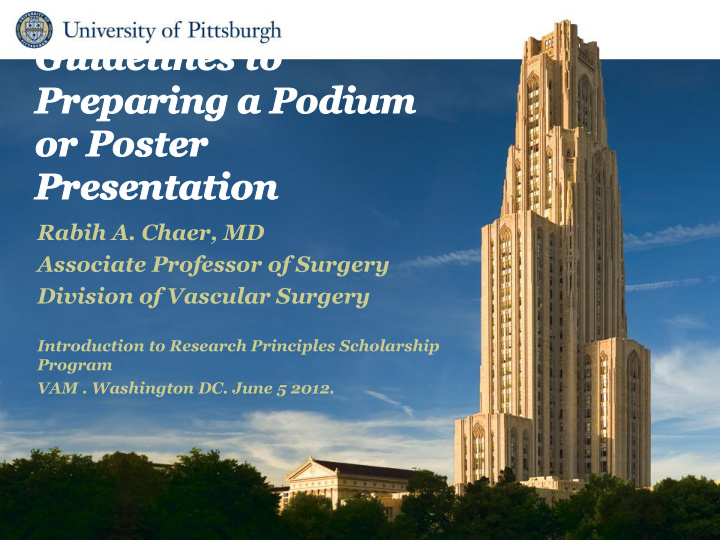



Guidelines Guidelines to to Prepar Preparing ing a Podium a Podium or Poster or Poster Presen Presentation tation Rabih A. Chaer, MD Associate Professor of Surgery Division of Vascular Surgery Introduction to Research Principles Scholarship Program VAM . Washington DC. June 5 2012.
DISCLOSURES DISCLOSURES • Nothing to disclose
Session Goals Learn key elements of • Poster design • Poster organization • Poster/Podium presentation
Hierarchy of Presentations • Local < National < International • Poster < Oral < Plenary
Advantages of Posters • More interactive • More opportunity for networking • Informal, collegial dialogue • More in-depth discussions? • A broader audience? • Greater graphic flexibility?
Anatomy of a Poster Session • 90 minutes • 100+ posters in a great big room • 100-1000s of people roaming the room – Often eating, drinking, some with babies… – Some reviewed the list of titles/authors • 200+ conversations at any given time – folks catching up with old friends • +/- a “distinguished professor tour”
Do folks look at Posters? • Meeting with 450 participants and 58 posters • Observers monitored 3 posters: Poster Glanced Studied Seconds Studied 1 23% 17% 36 sec 2 21% 12% 50 sec 3 8% 10% 84 sec Wright V. Br J Rheum 1987;26:292-294
Who Looks at Your Poster? • Friends and colleagues – Friends of friends and colleagues • Folks interested in your topic • Folks who happen to walk by • People who might hire you Ideally, all of these!
A poster is not a research paper stuck to a board!!
What Makes What Makes a Good a Good Poster/ Poster/ Presen Presentation? tation? • Sound hypothesis/rationale • Good experimental design • Tells a good and “complete” story • Understandable results • Clear and concise figures/tables • Reasonable discussion • Sound conclusions/summary
Common Poster Mistakes • Too much text • No images/graphs • Small font • Poor use of available space • Too much visual distraction • Lost message
Make the Message Clear • Display the essential content in the title, headings, and graphics • Use main headings to explain key points • Differentiate between data, summary, and conclusion
Titles are really important • Typical Title: “Outcomes of Recurrent Tibial Interventions for CLI” • Better Title: “Tibial Reinterventions for CLI are Associated with Increased Rates of Limb Loss”
Use your headings • Typical Heading: “Background” • Better Heading: “The Effect of Tibial Reinterventions for CLI is not appreciated”
General Format • Format the poster in columns rather than rows (like a newspaper) 1 4 1 2 3 2 5 VS. 4 5 6 3 6
Hierarchy of Text Size • Title: 90-120 point, bold • Subtitle: 72 point • Headings: 36-48 point • Text: 24-28 point • Details: 18-24 point
Poster Text • Use bullets • Avoid long sentences – < 65 characters is easily scanned – > 80 characters is harder • Edit, edit, edit
Avoid Visual Distraction 1 • Avoid jagged edges 3 2 • Use long visual lines • Line up panels • Keep it simple! • > 50% should be empty space
Graphics Should Dominate • Well-designed graphics are efficient and effective • Must be visible from > 4 feet away – Easier to point out • Place graphics in order of reading
The rainbow stops here • A single background color can unify the poster and eliminate distracting edges • If used judiciously, color can emphasize or link important data • Dark text on light background works best
Printing your poster • Single sheet posters: – Professional – Travel well (can be mailed to conference) – Handout friendly – Easy to post – Cost about $70 • Panel posters: – Cheap (very, if you do it yourself) – Potentially easier to travel with
Web Sites for Poster Preparation • Makesigns.com • http://biology.lsa.umich.edu/research/labs/ktosney/file/ PostersHome.html • http://www.ncsu.edu/project/posters/ • http://www.ncsu.edu/project/posters/GoodGraphs/ • http://SciencePresentations.com • http://www.postersession.com • www.posterpresentations.com • http://www.swarthmore.edu/NatSci/cpurrin1/posteradvi ce.htm • Go to Google and type “poster template Powerpoint”
Recommend
More recommend